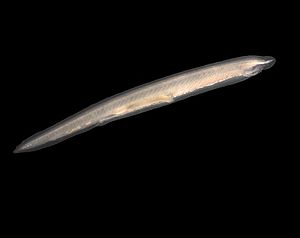- Leptocardia
-
Schädellose Systematik Unterreich: Vielzellige Tiere (Metazoa) Abteilung: Gewebetiere (Eumetazoa) Unterabteilung: Bilateria Überstamm: Neumünder (Deuterostomia) Stamm: Chordatiere (Chordata) Unterstamm: Schädellose Wissenschaftlicher Name Cephalochordata Owen, 1846 Die Schädellosen (Cephalochordata, Acrania oder Leptocardia) sind eine Gruppe der Chordatiere. Es sind fischförmige Lebewesen ohne knöchernen Schädel (cranium), Wirbelsäule und Extremitäten.
In der Erdgeschichte war diese Gruppe durch zahlreiche Arten vertreten, heute sind die einzigen noch lebenden (rezenten) Vertreter die Lanzettfischchen, ein artenarmes Taxon, mit den zwei Familien Asymmetronidae und Branchiostomatidae. Die Schädellosen stehen verwandtschaftlich den beiden übrigen Unterstämmen der Chordaten, den Manteltieren (Tunicata, Urochordata) und den Schädeltieren (Wirbeltieren), nahe. Oft wird ihr relativ einfacher Bauplan als modellhaft für die Entwicklung hin zu den Schädeltieren angesehen.
Inhaltsverzeichnis
Anatomie
1 Hirnbläschen
2 Chorda dorsalis
3 Neuralrohr, Rückenmark
4 Schwanzflosse
5 After
6 Verdauungskanal, Kiemendarm
7 Blutsystem (Hinweisstrich auf Darmvene)
8 Atriporus
9 Peribranchialraum10 Kiemenspalte
11 Kiemenbogen
12 Mundhöhle
13 Cirren
14 Mundöffnung
15 Gonaden (Eierstock/Hoden)
16 Lichtrezeptor
17 Nerven
18 Bauchfalte
19 LeberblindsackSchädellose im Fossilbericht
Die Körper von Schädellosen sind aufgrund fehlender knorpeliger oder knöchener Hartteile nur selten erhalten, daher ist ihre Entwicklungsgeschichte nur schlecht durch Fossilfunde dokumentiert.
Der älteste Schädellose
Die älteste bekannte Form ist Pikaia aus dem mittleren Kambrium vor etwa 525 Millionen Jahren aus dem für seine außergewöhnliche Weichteilerhaltung bekannten kanadischen Burgess-Schiefer.
Conodonten
Der bedeutendste Vertreter der Schädellosen ist die Gruppe der ausschließlich fossilen Conodonten (Conodonta), die vom Kambrium bis zur Obertrias auftraten und von denen mehr als 3.000 Arten bekannt sind. Ihre außerordentliche Formenvielfalt macht die Conodonten zu bedeutenden Leitfossilien für das Paläozoikum und das frühe Mesozoikum. Die Tiere waren lange Zeit nur in Form ihres zahnähnlichen, im Durchschnitt nur 0,1 bis 2 mm großen Conodonten-Apparates bekannt, der zur Nahrungsaufnahme diente und aus mehreren Conodonten-Elementen zusammengesetzt war. Erst 1983 wurde die Entdeckung eines zugehörigen, nur wenige Zentimeter langen „Conodonten-Tieres“ veröffentlicht.
Wikimedia Foundation.



